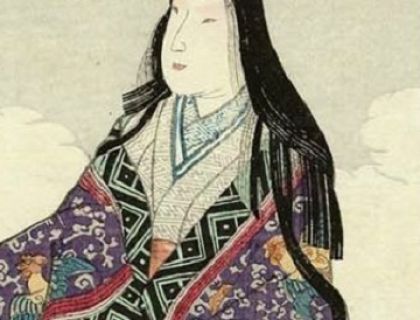The Empress Jito

.
.
The Empress Jito — an artifact in Cornell Botanic Gardens
The glyphs on the tree trunk are difficult to decipher. It is conceivable that they have been deliberately obfuscated to conceal their meaning. After careful microscopic analysis, here is a rendition of what appears to be an ancient Japanese text:
Haru sugite
Natsu ki ni kerashi
Shirotae no
Koromo hosu teu
Ama-no-kagu yama
The spring has gone, the summer’s come,
And I can just descry
The peak of Ama-no-kagu,
Where angels of the sky
Spread their white robes to dry.
The Empress Jitō reigned A.D. 690-696, during which time saké was first made and drunk in Japan; she was the daughter of the Emperor Tenchi, . . . and she married the Emperor Temmu, ascending the throne herself on his death. The poem refers to a snow-capped mountain just visible on the horizon. One of the Nō dramas relates, that an angel once came to a pine forest on the coast near Okitsu, and, hanging her feather mantle on a pine tree, climbed a neighbouring mountain to view Mount Fuji; a fisherman, however, found the robe and was about to carry it off with him, when the angel reappeared and begged him to give it her, as without it she could not return to the moon where she lived. He only consented to do so, however, on condition that she would dance for him; and this she accordingly did, draped in her feathery robe on the sandy beach under the shade of the pine trees; after which she floated heavenward, and was lost to view.
[Some of the text but not all is from: A Hundred Verses from Old Japan (The Hyakunin-isshu), tr. by William N. Porter, [1909], at sacred-texts.com]
This entry was posted in Blog and tagged angels of the sky, Cornell Botanic Gardens, fungus, hieroglyphs, tree trunk. Bookmark the permalink.

Leave a Reply